Processing data with R
Introducing R and RStudio Cloud
In today’s class we will work with R, which is a very powerful tool, designed by statisticians for data analysis. Described on its website as “free software environment for statistical computing and graphics,” R is a programming language that opens a world of possibilities for making graphics and analyzing and processing data. Indeed, just about anything you may want to do with data can be done with R, from web scraping to making interactive graphics.
Our main goal for today’s class is to get used to processing and analyzing data using the dplyr R package.
We will work in RStudio Cloud, a web-based “integrated development environment,” or IDE, for R that provides a user-friendly interface.
You should already have received an invitation to a shared UCSC SciCom workspace in RStudio Cloud.
When you login, you should see a page like this:
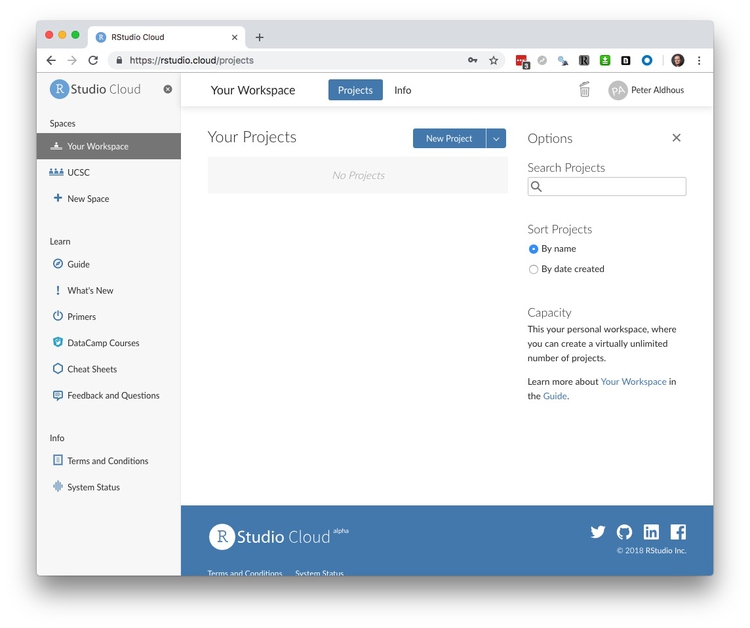
Make a project for your work in the UCSC workspace
In the panel at left, select the UCSC workspace and then click the New Project button. give it your name, in the format firstname-lastname, with no spaces, so that I know where to look for everyone’s work.
Close down the panel at left, and your screen should now look like this:
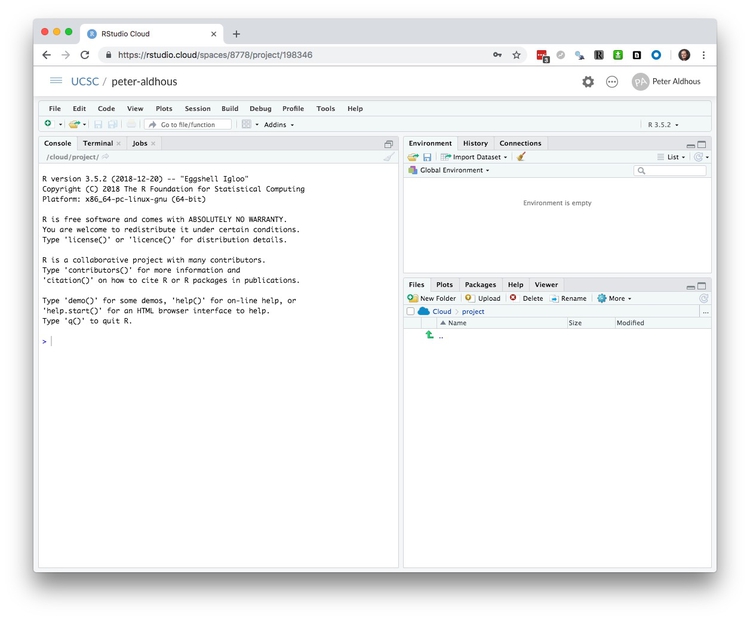
The main panel to the left is the R Console. It shows the version of R you are running, here 3.5.2.
Type valid R code into here, hit return, and it will be run. See what happens if you run:
print("Hello World!")
The data we will use today
Download the data for this session from here. You do not need to unzip. It contains the following files:
nations.csvData from the World Bank Indicators portal. Contains the following fields:iso2ciso3cTwo- and Three-letter codes for each country, assigned by the International Organization for Standardization.countryCountry name.yearpopulationEstimated total population at mid-year, including all residents apart from refugees.gdp_percapGross Domestic Product per capita in current international dollars, corrected for purchasing power in different territories.life_expectLife expectancy at birth, in years.populationEstimated total population at mid-year, including all residents apart from refugees.birth_rateLive births during the year per 1,000 people, based on mid-year population estimate.neonat_mortal_rateNeonatal mortality rate: babies dying before reaching 28 days of age, per 1,000 live births in a given year.regionincomeWorld Bank regions and income groups, explained here.
nations2.csvAgain from the World Bank Indicators portal. Contains the following fields:iso3cyearAs above.co2_percapCarbon dioxide emissions per capita metric tonnes.
kindergarten.csvData from the California Department of Public Health, documenting enrollment and the number of children with complete immunizations at entry into kindergartens in California from 2001 to 2014. Contains the following variables:districtSchool district.sch_codeUnique identifying code for each school.pub_privWhether school is public or private.schoolSchool name.enrollmentNumber of children enrolled.completeNumber of children with complete immunizations.start_yearYear of entry (for the 2014-2015 school year, for example, this would be 2014).
kindergarten_2015.csvAs above, but data from 2015 only.
Reproducibility: Save your scripts
Data journalism should ideally be fully documented and reproducible. R makes this easy, as every operation performed can be saved in a script, and repeated by running that script. Click on the  icon at top left and select
icon at top left and select R Script. A new panel should now open:
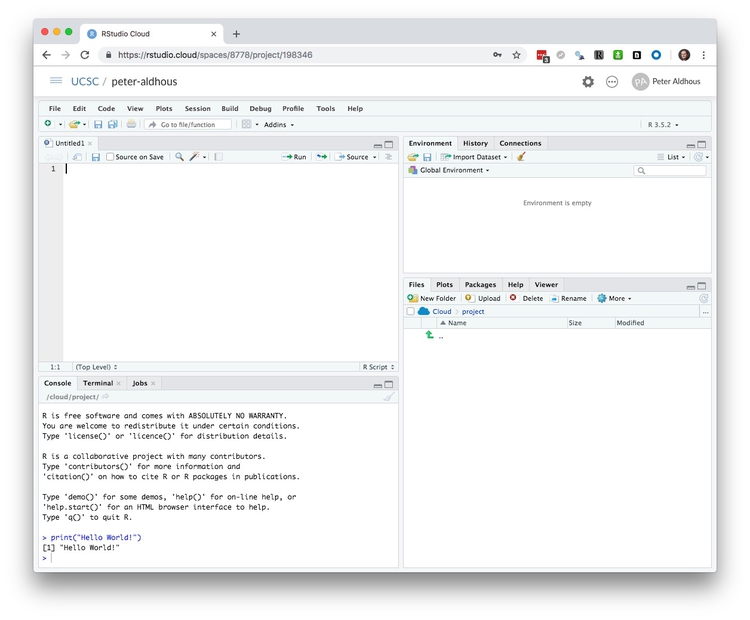
Any code we type in here can be run in the console. Hitting Run will run the line of code on which the cursor is sitting. To run multiple lines of code, highlight them and click Run.
Click on the save/disk icon in the script panel and save the blank script to the file on your desktop with the data for this week, calling it data_processing.R.
Set your working directory
In RStudio Cloud, your working directory is automatically the directory for the project in which you are working. But it’s good practice, if you are later going to work with RStudio Desktop on your own computer, to get into the habit of setting the working directory to the folder into which you have saved your script and the data with which you are going to work. To set the working directory to the folder containing your script, select from the top menu Session>Set Working Directory>To Source File Location.
Notice how the code below appears in the console:
setwd("/cloud/project")
Save your data
The panel at top right has three tabs, the first showing the Environment, or all of the “objects” loaded into memory for this R session. We can save this as well, so we don’t have to load and process data again if we return to return to a project later.
Click on the save/disk icon in the Environment panel to save and call the file data_processing.RData. You should see the following code appear in the Console:
save.image("/cloud/project/data_processing.RData")
Copy this code into your script, placing it at the end, with a comment, explaining what it does:
# save session data
save.image("/cloud/project/data_processing.RData")
Now if you run your entire script, the last action will be to save the data in your environment.
Comment your code
Anything that appears on a line after # will be treated as a comment, and will be ignored when the code is run. Use this to explain what the codes does. Get into the habit of commenting your code: Don’t trust yourself to remember!
Some R code basics
<-is known as an “assignment operator.” It means: “Make the object named to the left equal to the output of the code to the right.”&means AND, in Boolean logic.|means OR, in Boolean logic.!means NOT, in Boolean logic.- When referring to values entered as text, or to dates, put them in quote marks, like this:
"United States", or"2017-07-26". Numbers are not quoted. - When entering two or more values as a list, combine them using the function
c, with the values separated by commas, for example:c("2018-08-26","2018-09-04") - As in a spreadsheet, you can specify a range of values with a colon, for example:
c(1:10)creates a list of integers (whole numbers) from one to ten. Some common operators:
+-Add, subtract.*/Multiply, divide.><Greater than, less than.>=<=Greater than or equal to, less than or equal to.!=Not equal to.
Equals signs can be a little confusing, but see how they are used in the code we use today:
==Test whether an object is equal to a value. This is often used when filtering data, as we will see.=Make an object equal to a value; works like<-, but used within the parentheses of a function.
Handling null values:
- Nulls are designated as
NA. is.na(x)looks for nulls within variablex.!is.na(x)looks for non-null values within variablex.
- Nulls are designated as
In the code above, is.na, c, setwd, print, and so on are functions. Functions are followed by parentheses, and act on the data/code in the parenthesis.
Important: Object and variable names in R should not contain spaces.
Install and load R packages
Much of the power of R comes from the thousands of “packages” written by its community of open source contributors. These are optimized for specific statistical, graphical or data-processing tasks. To see what packages are available in the basic distribution of R, select the Packages tab in the panel at bottom right. To find packages for particular tasks, try searching Google using appropriate keywords and the phrase “R package.”
In this class, we will work with two incredibly useful packages developed by Hadley Wickham, chief scientist at RStudio:
- readr Reads and writes CSV and other text files.
- dplyr Processes and analyzes data, using the operations we discussed in the first class.
These and several other useful packages have been combined into a super-package called the tidyverse.
To install a package, click on the Install icon in the Packages tab, type its name into the dialog box, and make sure that Install dependencies is checked, as some packages will only run correctly if other packages are also installed. Click Install and all of the required packages should install:
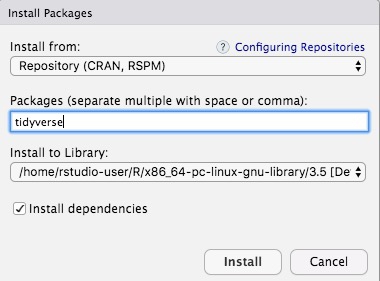
Notice that the following code appears in the console:
install.packages("tidyverse")
So you can also install packages with code in this format, without using the point-and-click interface.
Each time you start R, it’s a good idea to click on Update in the Packages panel to update all your installed packages to the latest versions.
Installing a package makes it available to you, but to use it in any R session you need to load it. You can do this by checking its box in the Packages tab. However, we will enter the following code into our script, then highlight these lines of code and run them:
# load packages to read, write and process data
library(readr)
library(dplyr)
At this point, and at regular intervals, save your script, by clicking the save/disk icon in the script panel, or using the ⌘-S or Ctrl-S keyboard shortcut.
Load and view data
Load data
Under the Files tab at bottom-right, select Upload and click Choose File to navigate to zipped folder data-processing-r.zip:
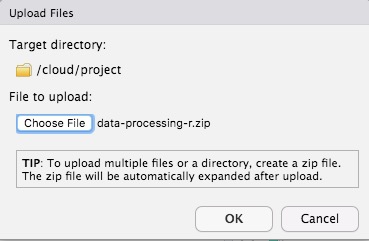
You can load data into the current R session by selecting Import Dataset>From Text File... in the Environment tab. Click OK to upload the data, which should load into your project.
You can load data into R using Import Dataset in the Environment tab. However, we will use the read_csv function from the readr package. Copy the following code into your script and Run:
# load nations data
nations <- read_csv("data-processing-r/nations.csv")
nations2 <- read_csv("data-processing-r/nations2.csv")
Notice that the Environment now contains two objects.
If your enviroment is in the List view (look at top right), use the drop-down menu to switch to the Grid view.
The two objects will be of type spec_tbl_df, a variety of the standard R object for holding tables of data, known as a data frame:
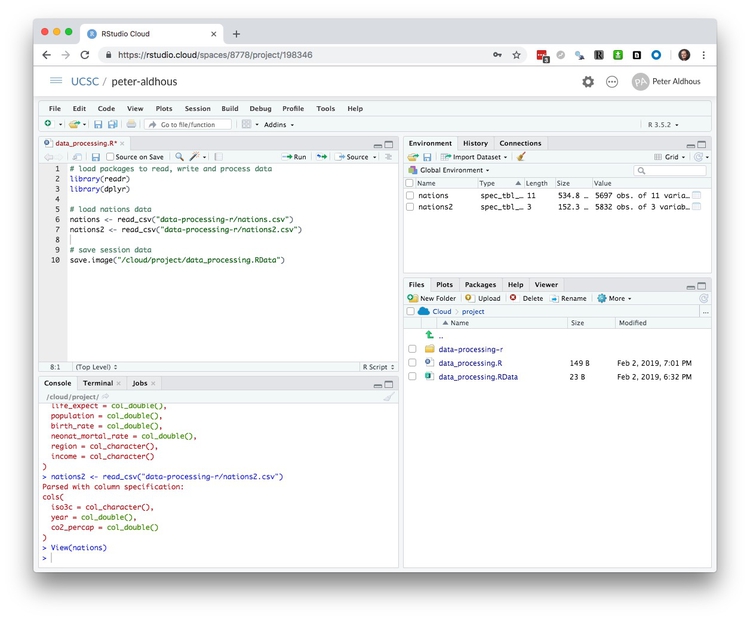
The Value for each data frame details the number of columns, and the number of rows, or observations, in the data.
You can remove any object from your environment by checking it in the Grid view and clicking the broom icon. You can also use the code rm(object).
Examine the data
We can View data at any time by clicking on its table icon in the Environment tab in the Grid view, or with the code View(object).
The glimpse function will tell you more about the columns in your data, including their data type. Copy this code into your script and Run:
# view structure of data
glimpse(nations)
This should give the following output in the R Console:
Observations: 5,697
Variables: 11
$ iso2c <chr> "AD", "AD", "AD", "AD", "AD", "AD", "AD", "AD",…
$ iso3c <chr> "AND", "AND", "AND", "AND", "AND", "AND", "AND"…
$ country <chr> "Andorra", "Andorra", "Andorra", "Andorra", "An…
$ year <dbl> 2007, 2011, 2013, 2008, 1992, 2006, 2009, 2010,…
$ gdp_percap <dbl> NA, NA, NA, NA, NA, NA, NA, NA, NA, NA, NA, NA,…
$ life_expect <dbl> NA, NA, NA, NA, NA, NA, NA, NA, NA, NA, NA, NA,…
$ population <dbl> 82683, 83751, 80788, 83861, 58888, 80991, 84462…
$ birth_rate <dbl> 10.1, NA, NA, 10.4, 12.1, 10.6, 9.9, 9.8, 10.9,…
$ neonat_mortal_rate <dbl> 1.5, 1.3, 1.2, 1.4, 3.6, 1.6, 1.4, 1.3, 3.1, 3.…
$ region <chr> "Europe & Central Asia", "Europe & Central Asia…
$ income <chr> "High income", "High income", "High income", "H…
chr means “character,” or a string of text (which can be treated as a categorical variable); int means an integer or whole number; dbl means a number that can contain decimal fractions; dttm means a date-time variable.
If you run into any trouble importing data with readr, you may need to specify the data types for some columns — in particular for date and time. This link explains how to set data types for individual variables when importing data with readr.
To specify an individual column use the name of the data frame and the column name, separated by $. Type this into your script and run:
# print values for population in the nations data
nations$population
The output will be the first 1,000 values for that column.
If you need to change the data type for any column, use the following functions:
as.characterconverts to a text string.as.numericconverts to a number that can include decimal fractions.as.factorconverts to a categorical variable.as.integerconverts to an integer.as.Dateconverts to a date.as.POSIXctconverts to a full date and timestamp.
(To convert a date/time written as a string of text to a date or a full timestamp, you may also need to specify the format, see here for more.)
This code will convert the population numbers from integers to numbers that could hold decimal fractions:
# convert population to integer
nations$population <- as.integer(nations$population)
glimpse(nations)
Notice that the data type for population has now changed:
Observations: 5,697
Variables: 11
$ iso2c <chr> "AD", "AD", "AD", "AD", "AD", "AD", "AD", "AD",…
$ iso3c <chr> "AND", "AND", "AND", "AND", "AND", "AND", "AND"…
$ country <chr> "Andorra", "Andorra", "Andorra", "Andorra", "An…
$ year <dbl> 2007, 2011, 2013, 2008, 1992, 2006, 2009, 2010,…
$ gdp_percap <dbl> NA, NA, NA, NA, NA, NA, NA, NA, NA, NA, NA, NA,…
$ life_expect <dbl> NA, NA, NA, NA, NA, NA, NA, NA, NA, NA, NA, NA,…
$ population <int> 82683, 83751, 80788, 83861, 58888, 80991, 84462…
$ birth_rate <dbl> 10.1, NA, NA, 10.4, 12.1, 10.6, 9.9, 9.8, 10.9,…
$ neonat_mortal_rate <dbl> 1.5, 1.3, 1.2, 1.4, 3.6, 1.6, 1.4, 1.3, 3.1, 3.…
$ region <chr> "Europe & Central Asia", "Europe & Central Asia…
$ income <chr> "High income", "High income", "High income", "H…
>
The summary function will run a quick statistical summary of a data frame, calculating mean, median and quartile values for continuous variables:
# summary of nations data
summary(nations)
Here is the console output:
iso2c iso3c country year
Length:5697 Length:5697 Length:5697 Min. :1990
Class :character Class :character Class :character 1st Qu.:1996
Mode :character Mode :character Mode :character Median :2003
Mean :2003
3rd Qu.:2010
Max. :2016
gdp_percap life_expect population birth_rate
Min. : 242 Min. :27.61 Min. :9.003e+03 Min. : 6.90
1st Qu.: 2338 1st Qu.:62.06 1st Qu.:7.457e+05 1st Qu.:13.23
Median : 6844 Median :70.70 Median :5.379e+06 Median :21.45
Mean : 13530 Mean :68.19 Mean :3.001e+07 Mean :23.90
3rd Qu.: 18154 3rd Qu.:75.39 3rd Qu.:1.799e+07 3rd Qu.:33.57
Max. :140037 Max. :85.42 Max. :1.379e+09 Max. :55.56
NA's :779 NA's :429 NA's :16 NA's :312
neonat_mortal_rate region income
Min. : 0.60 Length:5697 Length:5697
1st Qu.: 6.00 Class :character Class :character
Median :14.50 Mode :character Mode :character
Mean :18.92
3rd Qu.:28.70
Max. :75.00
NA's :567
Process and analyze data with dplyr
Now we will use dplyr to process the data, using the basic operations we discussed in the first class:
Sort: Largest to smallest, oldest to newest, alphabetical etc.
Filter: Select a defined subset of the data.
Summarize/Aggregate: Deriving one value from a series of other values to produce a summary statistic. Examples include: count, sum, mean, median, maximum, minimum etc. Often you’ll group data into categories first, and then aggregate by group.
Join: Merging entries from two or more datasets based on common field(s), e.g. unique ID number, last name and first name.
Here are some of the most useful functions in dplyr:
selectChoose which columns to include.filterFilter the data.arrangeSort the data, by size for continuous variables, by date, or alphabetically.group_byGroup the data by a categorical variable.summarizeSummarize, or aggregate (for each group if followinggroup_by). Often used in conjunction with functions including:mean(x)Calculate the mean, or average, for variablex.median(x)Calculate the median.max(x)Find the maximum value.min(x)Find the minimum value.sum(x)Add all the values together.n()Count the number of records. Here there isn’t a variable in the brackets of the function, because the number of records applies to all variables.n_distinct(x)Count the number of unique values in variablex.
mutateCreate new column(s) in the data, or change existing column(s).renameRename column(s).bind_rowsAppend one data data frame to another, combining data from columns with the same name.uniqueremove duplicate rows.
There are also various functions to join data, which we will explore below.
These functions can be chained together using the “pipe” operator %>%, which makes the output of one line of code the input for the next. This allows you to run through a series of operations in a logical order. I find it helpful to think of %>% as meaning “then.”
Filter and sort data
Now we will filter and sort the data in specific ways. For each of the following examples, copy the code that follows into your script, and view the results. Notice how we create new objects to hold the processed data.
Filter the data for 2016 only
# filter data for 2016 only, and select columns for country, life expectancy, income group, and region
longevity <- nations %>%
filter(year == 2016 & !is.na(life_expect)) %>%
select(country, life_expect, income, region)
In this code, we created a new object called longevity from nations and then (%>%) filtered it for just the data for 2016 and to include only non-null values. Then we selected just four variables from the 11 in the original data frame. There should be data returned for 195 countries.
Here are the first few records in the new object:
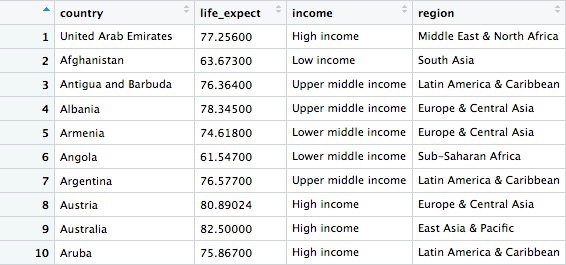
Find the ten high-income countries with the shortest life expectancy in 2016
# find the ten high-income countries with the shortest life expectancy
high_income_short_life <- longevity %>%
filter(income == "High income") %>%
arrange(life_expect) %>%
head(10)
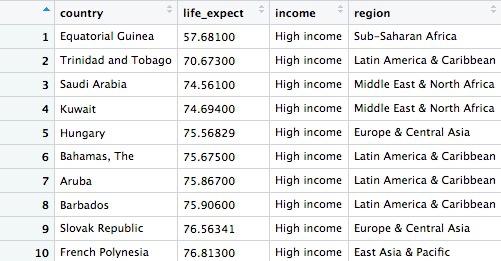
This code takes the previous longevity object, filters it for countries in the high income group only, then sorts the data, using arrange (the default is ascending order). Finally it uses head(10) to return the first ten countries in the sorted data.
Find countries in North America or Europe & Central Asia with a life expectancy in 2016 of between 75 and 80.
# find countries in North America or Europe & Central Asia with a life expectancy in 2016 of 75 - 80
eur_na_75_80 <- longevity %>%
filter(life_expect > 75 & life_expect < 80 & (region == "Europe & Central Asia" | region == "North America")) %>%
arrange(desc(life_expect))
This should be the result:
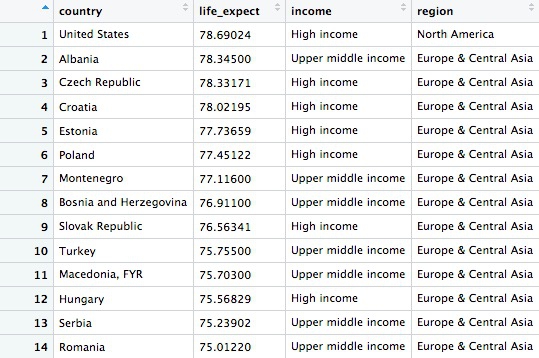
Whereas in the initial filter of the data to create the longevity data frame we used & to return data meeting both criteria, this time we also used | to include data meeting either criteria. & and | are equivalent to AND and OR in Boolean logic. Notice how the | part of the filter is wrapped in parentheses. Look at what happens if you remove them, and work out what is going on.
Note: When combining & and | in more complex filters, use parentheses to determine which parts of the evaluation should be carried out first.
Find the 20 countries with the longest life expectancy in 2016, plus the United States with its rank, if it lies outside the top 20
# find the 20 countries with the longest life expectancies,
# plus the United States with its rank, if it lies outside the top 20
long_life <- longevity %>%
mutate(rank_le = rank(desc(life_expect))) %>%
arrange(rank_le) %>%
filter(rank_le <= 20 | country == "United States")
This should be the result, showing the United States to rank a lowly 42nd:
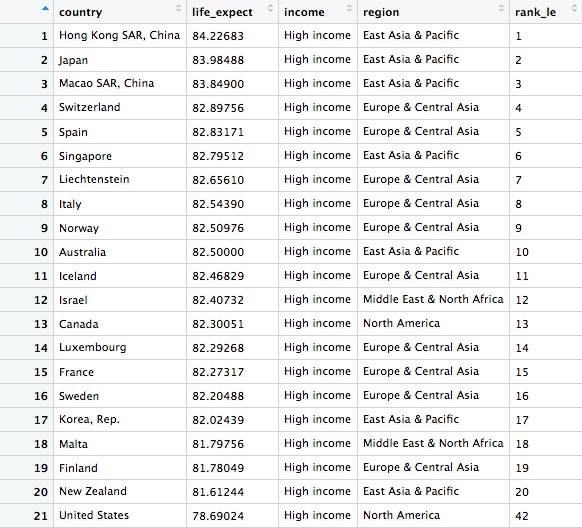
Here we started by creating a new variable in the data called rank_le, using the mutate function from dplyr and the rank function (https://www.rdocumentation.org/packages/base/versions/3.4.3/topics/rank) from base R.
Finally we filtered the data for the top 20 countries, plus the United States.
Notice also in this code that a single = is used to change or create values, while == is used to test whether a value is equal to something.
This code produces exactly the same result, Make sure you understand why:
long_life <- nations %>%
filter(year == 2016 & !is.na(life_expect)) %>%
select(country, life_expect, income, region) %>%
mutate(rank_le = rank(desc(life_expect))) %>%
arrange(rank_le) %>%
filter(rank_le <= 20 | country == "United States")
Now let’s find out where Russia ranks, too
# find the 20 countries with the longest life expectancies,
# plus the United States and Russia with their ranks
long_life <- longevity %>%
mutate(rank_le = rank(desc(life_expect))) %>%
arrange(rank_le) %>%
filter(rank_le <= 20 | grepl("United States|Russia", country))
This should be the result:
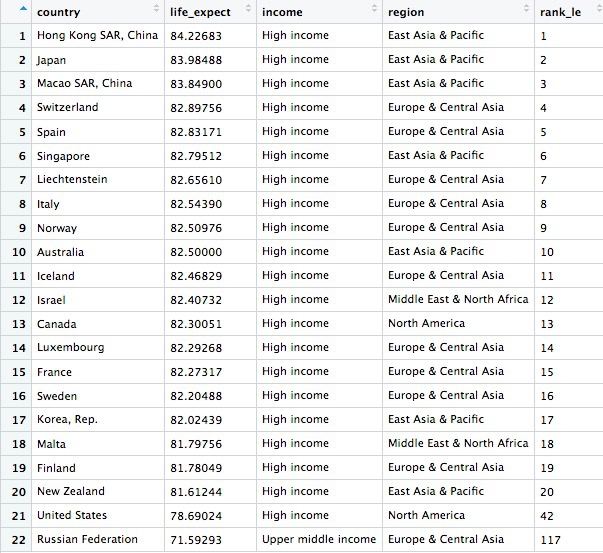
This code demonstrates some simple pattern matching on text, using the function grepl("pattern_a|pattern_b", x), which searches variable x for values containing any of a list of text values. This is useful for fuzzy text matching. Notice how searching for Russia returns Russian Federation, which is the country’s full name. (!grepl will return text strings that don’t contain the specified pattern.)
Note: You can overwrite an object by assigning some new code to the same name used previously.
Some practice with filtering and sorting
Find the countries with a life expectancy of between 50 and 60 years in 1990, arranged in descending order of life expectancy.
Find upper middle and lower middle income countries with a life expectancy of between 60 and 70 in 1990. Sort in descending order of life expectancy.
Find countries that in 1990 had a GDP per capita of more than $50,000 dollars and a life expectancy of 70 years or more that were not in Europe or North America. Sort them in ascending order of life expectancy.
Write data to a CSV file
readr can write data to CSV and other text files. This code will save the result above to a CSV file in your working directory:
# write data to a csv file
write_csv(long_life, "long_life.csv", na="")
Although we have no null values here, including na="" is good practice, because it ensures that any empty cells in the data frame are saved as blanks, not NA.
Group and summarize data
Summarize the longevity data by year, finding the country-level maximum, minimum, and range.
# summarize the data by year, finding the maximum and minimum country-level life expectancies, and then calculate the range of values
longevity_summary <- nations %>%
filter(!is.na(life_expect)) %>%
group_by(year) %>%
summarize(countries = n(),
max_life_expect = max(life_expect),
min_life_expect = min(life_expect)) %>%
mutate(range_life_expect = max_life_expect - min_life_expect) %>%
arrange(desc(year))
This should be the first few rows in the data:
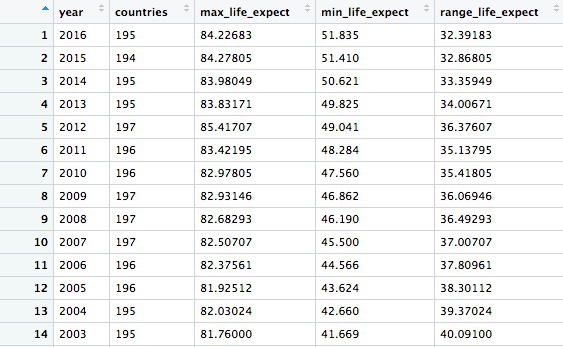
This code introduces the functions group_by and summarize. The entire summarize function could be written on one line, but I have started a new line after each summary statistic for clarity.
In this example, we calculated the number of countries for which we have data in each year, then the maximum and minimum country-level life expectancies. Having done that, we used the mutate function to calculate the range of values by subtracting the minimum from the maximum.
Calculate total GDP by region and year
# total GDP, in trillions of dollars, by region, over time
gdp_regions <- nations %>%
mutate(gdp = gdp_percap * population,
gdp_tn = gdp/1000000000000) %>%
group_by(region, year) %>%
summarize(total_gdp_tn = sum(gdp_tn, na.rm = TRUE))
This should be the first few rows in the data:

We could also write 10^12 (10 raised to the power of 12) instead of 1000000000000 in this example.
Notice that variables created within a mutate function can be immediately used within the same function.
Here the group_by function groups on two variables, region and year.
Notice that the sum function used to add up the GDP values across countries within each region and year includes the argument na.rm = TRUE, to remove the NA values before running the calculation. See what happens if you don’t include this. Previously this wasn’t necessary because I had started by filtering out the NAs.
Note: Get into the habit of including na.rm = TRUE in your summary functions, to avoid problems caused by null values!
Some practice with grouping and summarizing (and filtering and sorting)
Calculate the total GDP by income group and year. Sort the results in descending order of years and, within year, in descending order of GDP.
Calculate the total GDP for the East Asia & Pacific region, by income group and year.
Join data from two data frames
There are also a number of join functions in dplyr to combine data from two data frames. Here are the most useful:
inner_joinreturns values from both tables only where there is a match.left_joinreturns all the values from the first-mentioned table, plus those from the second table that match.semi_joinfilters the first-mentioned table to include only values that have matches in the second table.anti_joinfilters the first-mentioned table to include only values that have no matches in the second table.
Here is a useful reference for managing joins with dplyr.
This code will join nations2 to nations
# join nations to nations2
nations <- inner_join(nations, nations2)
See what happens if you use left_join or right_join.
By default, dplyr looks for variables with matching names, here iso3c and year, and joins on those. But you can also specify exactly how a join should be made, like this:
# join nations to nations2
nations <- inner_join(nations, nations2, by = c("iso3c" = "iso3c", "year" = "year"))
Calculate total carbon dioxide emissions by region and year
In the joined data frame, we can now calculate the total carbon dioxide emissions for each country and each year, and then add up the totals by region over the years:
# total carbon dioxide, in gigatonnes, by region, over time
co2_regions <- nations %>%
filter(year <= 2014) %>%
mutate(co2 = co2_percap * population / 10^9) %>%
group_by(region, year) %>%
summarize(total_co2 = sum(co2, na.rm = TRUE))
Here are the first few rows in the data:

The carbon dioxide emissions data ends in 2014, so first we filtered the data to remove the subsequent two years, before creating a new variable for total emissions from the per capita value, dividing by a billion, or 10 to the power of nine, to get the result in billions of tonnes (gigatonnes). Finally we grouped and summarized by year and region.
Load California kindergarten immunization data
Now we’ll work with the California immunization data.
# load data
immun <- read_csv("kindergarten.csv", col_types = list(
county = col_character(),
district = col_character(),
sch_code = col_character(),
pub_priv = col_character(),
school = col_character(),
enrollment = col_integer(),
complete = col_integer(),
start_year = col_integer()))
immun_2015 <- read_csv("kindergarten_2015.csv", col_types = list(
county = col_character(),
district = col_character(),
sch_code = col_character(),
pub_priv = col_character(),
school = col_character(),
enrollment = col_integer(),
complete = col_integer(),
start_year = col_integer()))
We need to append the data for 2015 to the older data. So this code specifies the data type for each variable, to be sure that there won’t be any mismatches in data type that would cause an error in the next step.
Append the 2015 data to the older data using bind_rows
# append the 2015 data to the older data
immun <- bind_rows(immun, immun_2015)
This code introduces the bind_rows function, which appends one data frame to another, based on matching column names and data types. (If a column exists in one data frame but not in the other, NAs will be added where necessary.)
Calculate the percentage of children with incomplete immunizations, for the entire state, and by county
The data contains the number of children enrolled in each kindergarten across the state, and the number who had the complete recommended immunizations at the start of the year.
From this, we can calculate the percentage of children who did not have the complete schedule of immunizations. The following code runs these calculations for each year, first for the entire state, summing across all kindergartens grouped by year, and then for each of California’s 58 counties, by changing the group_by function.
# percentage incomplete, entire state, by year
immun_year <- immun %>%
group_by(start_year) %>%
summarize(enrolled = sum(enrollment, na.rm=TRUE),
completed = sum(complete, na.rm=TRUE)) %>%
mutate(pc_incomplete = round(((enrolled-completed)/enrolled*100),2))
This should be the result:

Notice how the round(x,n) function is used to round values for x, here the percentage incomplete calculation, to n decimal places, here 2. Using negative numbers for n will round to tens (-1), hundreds (-2), and so on.
# percentage incomplete, by county, by year
immun_counties_year <- immun %>%
group_by(county,start_year) %>%
summarize(enrolled = sum(enrollment, na.rm = TRUE),
completed = sum(complete, na.rm = TRUE)) %>%
mutate(pc_incomplete = round(((enrolled-completed)/enrolled*100),2))
Here are the first few rows of the data that should be returned:

Now we can identify the five largest counties with the largest enrollment over the years, and use a join to filter the data by counties for just these five:
# identify five counties with the largest enrollment over all years
top5 <- immun %>%
group_by(county) %>%
summarize(enrolled = sum(enrollment, na.rm = TRUE)) %>%
arrange(desc(enrolled)) %>%
head(5) %>%
select(county)
# proportion incomplete, top 5 counties by enrollment, by year
immun_top5_year <- semi_join(immun_counties_year, top5)
Notice the use of semi_join to filter the data for just the five counties with the largest kindergarten enrollment.
Exporting files from RStudio Cloud
Check the files you want to export in the Files tab at bottom right. Then select More>Export and at the dialog box click Download. This will export the files you have selected to your local machine.
Clean up and close your RStudio Cloud session
Before you exit RStudio Cloud, save and close your script, save the data in your Environment, and close any data files you have open in View. Click the broom icon in the environment to clear the objects in memory. Finally, in the Console, type Ctrl-L to clear the console.
Further reading
RStudio Data Wrangling Cheet Sheet
Also introduces the tidyr package, which can manage wide-to-long transformations, and text-to-columns splits, among other data manipulations.
Stack Overflow
For any work involving code, this question-and-answer site is a great resource for when you get stuck, to see how others have solved similar problems. Search the site, or browse R questions
RStudio Cloud Resources
The Learn section in the RStudio Cloud panel at left has Primers, Cheat Sheets, and other resources.